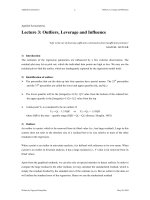Lecture 3 work and energy 2015
Bạn đang xem bản rút gọn của tài liệu. Xem và tải ngay bản đầy đủ của tài liệu tại đây (261.28 KB, 13 trang )
Lecture 4
WORK and ENERGY
OUTLINE
•
•
•
•
Work and Kinetic Energy
The Work-Kinetic Energy Theorem
Power
Conservative Force-Nonconservative
Force
• Potential Energy
• Mechanical Energy
• Conservation of Mechanical Energy
4.1 Work and Kinetic Energy
The work done by a constant force F on the object when it
moves a straight distance s is:
F=const
W Fs cos F .s
s
In general case, the work is not constant, the path is a curve.
The work done by force F when the object moves a very small
displacement ds (we can consider F constant and ds a straigh
linet:
F
ds
(1)
(2)
dv
dW F .ds m .ds mv dv
dt
The work done by force F when the object moves from position (1) to (2) is:
v2
1 1
W F .ds mv dv mv22 mv12
2
2
1
v1
2
We define: Kinetic Energy:
K
1 2
mv
2
The total work done on a particle is equal to the change in its kinetic energy
1
1
W K mv22 mv12
Work-Kinetic Energy Theorem
2
2
4.2 Power
work _ done
Power
per _ unit _ of _ time
dW F .ds
P
F .v
dt
dt
t2
W dW Pdt
t1
if P const W Pt
1 2 1 2
W mv2 mv1
2
2
1 2 1 2
mv2 mv1
W 2
2
t
P
P
Conservative
Nonconservative Force
1. Definition: A force is Conservative if the
work done by the force is independent on
the path, it is dependent only on the
initial and final position.
- Gravity and spring force are
conservative forces,while kinetic friction
is not.
2. Work done by Gravitation Force:
(1)
r1
Fgrv
dr
m
ds
Work done by the grav. force F on object
m when it moves a displacement ds:
Mm
dW F .ds F .ds
.
cos
G
dr
2
r
dr
(2)Work done by the grav. force F on object
m when it moves from (1) to (2)
r
r2
2
M
G 6.67 10 11 N .m2 / kg 2
Mm
Mm
Mm
W G 2 dr G
G
r
r2
r1
r1
Universal Graviattional Cconstant
+ Work done is independent of the path, but of the initial and final position
gravitation force is conservative.
+ we define a scalar quantity called gravitational potential energy of two object
sseparated by a distance r :
Mm
U ( r ) G
r
C
If we choose U=0 when r=, we have C=0, If we choose U=0 on the
surface of Earth: C=GMm/R
We can write: W U1 U 2 U
Conservative Forces
1. The work done by a conservative force on a particle moving
between any two points is independent of the path taken by
the particle.
2. The work done by a conservative force on a particle moving
through any closed path is zero. (A closed path is one in
which the beginning and end points are identical.)
3. the work Wc done by a conservative force on an object as
the object moves from one position to another is equal to the
initial value of the potential energy minus the final value.
(2)
(a)
W12 Fc. .ds
(1a 2 )
F
(b)
(1)
ds
(1)(2)
Fc..ds U1 U 2 U
(1b 2 )
W Fc. .ds 0
(C )
Mechanical Energy
ma Fc Fnc
• If an object is exerted by
Conservative Force Fc
and Nonconservative
Force Fnc,
• from the Work-Kinetic
Energy Theorem :
• Fc is conservative:
WFc U U1 U 2 (2)
• From (1) and (2):
K 2 K1 U1 U 2 WFnc
K K 2 K1 WFc WFnc (1)
( K 2 U 2 ) ( K1 U1 ) WFnc
• Mechanical Energy:
E=K+U
E E2 E1 WFnc
Conservation of Mechanical
Energy
The change in Mechnaical energy of an
object is equal to the work done by
nonconservative force on the object as it
takes a path form position (1) to (2)
E E2 E1 WFnc
If Fnc= 0 or WFnc =0 =>E=0: E=const
Conservation of Mechanical Energy
Conservative Force
& Potential Energy
F Fx i Fy j Fz k ds dxi dyj dzk
dW Fc .ds Fx dx Fy dy Fz dz
(1)
F _ is _ conservative
U
U
U
dW dU
dx
dy
dz (2)
y
z
x
U
U
U
Fx
; Fy
; Fz
x
y
z
F gradU
Gradient Operator
grad i
j k
x
y
z
Lực bảo tòan và thế năng
p p p
F grad p (
ex
ey
ez )
x
y
z
Dao động xung quanh vị trí cân bằng
bền
Khai triển Taylor hàm thế năng xung quanh vị trí cân bằng:
p
1 p
p ( x) p ( xe )
( x xe ) . 2
( x xe ) 2
x x x
2 x x x
e
e
0
vị trí cân
bằng
1
p ( x) p ( xe ) k .( x xe ) 2
2
Fx p / x k ( x xe )
mx k ( x xe )
2
k
bền k>0
ko bền k<0
x xe x
m k
k 0 2 0
Pt chuyển động xq vị trí cân bằng
bền
2 0
Độ lệch khỏi vị trí cân bằng
x xe
Tần số dao động
k
m
2 p
k 2
0
x
( x xe )









